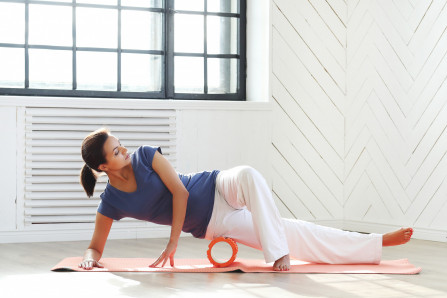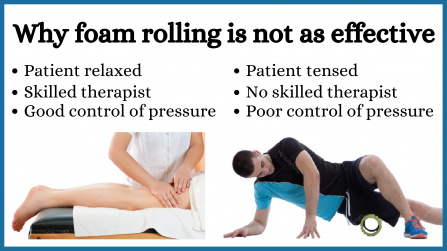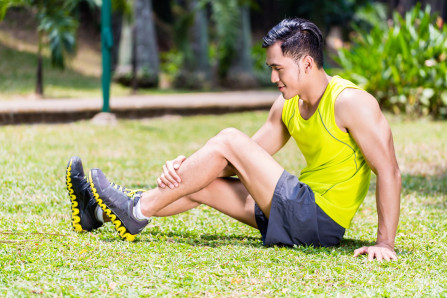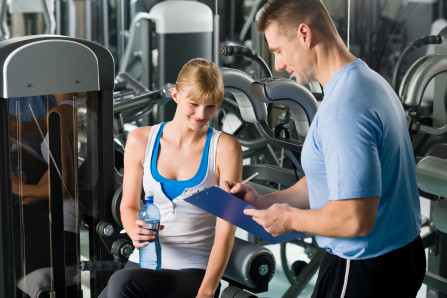Can foam rollers be harmful

Although clinical trials have shown the use of foam rollers to be safe, experts warn they can be dangerous. The reason trials show they are safe but experts say they can be harmful that in clinical trials patients are chosen for suitability then given thorough instructions and supervision. In the real world people use foam rollers on conditions they shouldn’t without instruction and supervision.
In this article we will discuss:
The real world risks of foam rolling
As mentioned above, in clinical trials patients are chosen for suitability then given extensive instructions and supervision. In the real world there is no supervision, users have little knowledge of technique or anatomy, rolling can require the adoption of awkward positions, and it is hard to control pressure.
Because of this:
- people use rollers on conditions they shouldn’t,
- they use inappropriate pressure, and
- press on sensitive things like nerves and blood vessels.
This is why as a chiropractor for over 27 years I saw a lot of people hurt themselves, and the once scientist made the following comments.
"During Foam-rolling exercises, all the underlying tissue is mechanically stressed, potentially leading to damage, receptors, vessels, or bones. This concern especially rises in users with diseases, for example, diabetes, varices or osteoporosis" (1)
Do the benefits justify the risks?
In summary, there are very few potential benefits to justify these risks. There have been many clinical trials of foam roller usage and the results have been mediocre at best. We have a table summary of the trials and scientific papers below if you wish to check these out. Consider also that these clinical trial results represent the best possible outcomes with optimum conditions. Real world results will likely be worse.

Why are foam rolling results so bad?
For the following reasons rolling is extremely unlikely to be anywhere near as effective as a professional therapist
- Self users rarely have the skill or knowledge of a professional therapist
- It can be difficult to get into the needed positions and apply the correct pressure
- Most importantly, when consulting a professional therapist you are usually lying relaxed on a table. However, when using a foam roller the muscles being massaged are often tightened just to get into the appropriate position. Massage won’t relax muscles if you are trying to tighten them at the same time.
How to reduce the risks of foam rolling
The best way to reduce the risk of foam rolling is to use one of the alternatives discussed below. If you do use foam rollers though these should help.
Restrict the usage to healthy uninjured muscles
Using foam rollers on healthy uninjured muscles is relatively safe. Examples would be use as preparation for or recovery after a workout. Do not use on any injured muscles or if there is a pain syndrome unless specifically instructed to do so by a properly qualified professional.
Do not use painful pressure techniques
We've see that the big danger is pressure techniques. It is much safer to use techniques where the muscles are gradually squeezed. We describe this to patients as like squeezing out an old sponge. If you use a foam roller these techniques will be much safer, and you will likely get better results.
Some safer and more effective alternatives
Foam rollers are marketed for the following uses. For each we will give far safer and more effective alternatives.
Pre-exercise warm-ups
Please see our article: Warm-ups: a guide to reducing injuries, increasing performance, and reducing post exercise soreness

Increasing flexibility
Foam rolling will increase flexibility, but this lasts less than 10 minutes. Stretching exercises are tried and proven, their effects last, and there is none of the risks involved with applying pressure.
Post exercise recovery
Please see our article: The practical, science based guide to post exercise recovery
Injuries and rehabilitation
The two best therapies for these are:
- massage by a professional therapist, and
- using a genuine vibration massager
Genuine vibration massagers are suitable for self use, which gives them a huge advantage. You not only save money, but it makes it practical to get all the care you need. For an example of this usage please see our article How to release trigger points yourself . Please note that you will need a genuine vibration massager. Massager guns and "consumer" personal massagers are an ineffective waste of money . Please see our article How to choose a massager .
Summary clinical trial trial results and scientific papers
The following table summarises the clinical trial results from using foam rollers. Keep in mind that because of the issues we've discussed these results represent the ideal usage, and even then they are not that great. Real world usage probably won't even be as good.
Reference |
Type of study |
Results and comments |
|---|---|---|
Review of 75 studies and other scientific papers |
Poor and conflicting evidence of any benefits, plus concern about the potential risks |
|
Review of studies |
Rolling improves flexibility, but these gains decline rapidly after rolling. Effects are not better than standard stretching |
|
Tested tenderness of iliotibial band (ITB) after foam rolling |
Foam rolling reduced tenderness |
|
Tested foam rollers for sports recovery |
Reduced post exercise soreness and increased blood flow |
|
Review of 21 studies of foam rolling |
Quote: Overall, it was determined that the effects of foam rolling on performance and recovery are rather minor and partly negligible, but can be relevant in some cases (e.g., to increase sprint performance and flexibility or to reduce muscle pain sensation). Evidence seems to justify the widespread use of foam rolling as a warm-up activity rather than a recovery tool. |
|
Tested both foam roller and vibrating roller on calf muscle flexibility |
Both showed improvement |
|
Tested vibrating and non vibrating rollers for flexibility, pain and tenderness |
Vibration rollers gave better results |
|
Tested the effect of foam rollers on hamstring flexibility |
Foam rollers produced no improvement |
|
9. |
Review of 15 studies of foam rolling |
Could not conclude any optimal program |
Tested effects of foam rollers on knee range of movement |
The massage was painful, but increased range of movement |
|
Review of 9 studies of foam rolling |
If used before or after exercise it can reduce soreness |

Fitness and exercise professionals
There is a lot of well meaning but too often poor advice and marginal therapies (eg. foam rollers and massage guns) aimed at those who exercise or play sports. We’d like professionals in these fields to have the opportunity to instead try and use practitioner grade therapy using genuine professional grade vibration massagers with a long list of scientifically demonstrated benefits. Please check out our practitioner page to access our practitioner guides and most importantly the special practitioner rates we give qualifies practitioners such as Chiropractors, Osteopaths and Physiotherapists.
References
- Freiwald J, Baumgart C, Kühnemann M, Hoppe MW. Foam-Rolling in Sport und Therapy- Potential benefits and risks. Sport Orthop Traumatol. 2016;32(3):267–75.
- DeBruyne DM, Dewhurst MM, Fischer KM, Wojtanowski MS, Durall C. Self-mobilization using a foam roller versus a roller massager: Which is more effective for increasing hamstrings flexibility? J Sport Rehabil. 2017;26(1):94–100.
- Vaughan B, McLaughlin P. Immediate changes in pressure pain threshold in the Iliotibial band using a myofascial (foam) roller. Int J Ther Rehabil. 2014;21(12):569–74.
- Adamczyk JG, Gryko K, Boguszewski D. Does the type of foam roller influence the recovery rate, thermal response and DOMS prevention? PLoS One
- Weiwlhove T. A Meta-Analysis of the effects of foam rolling on perforrmance and recovery. Front Physiol. 2019;10:376.
- de Benito AM, Valldecabres R, Ceca D, Richards J, Igual JB, Pablos A. Effect of vibration vs non-vibration foam rolling techniques on flexibility, dynamic balance and perceived joint stability after fatigue. PeerJ. 2019;2019(11):1–17.
- Romero-Moraleda B, González-García J, Cuéllar-Rayo Á, Balsalobre-Fernández C, Muñoz-García D, Morencos E. Effects of Vibration and Non-Vibration Foam Rolling on Recovery after Exercise with Induced Muscle Damage. J Sports Sci Med 2019;18(1):172–80.
- Miller JK, Rockey AM. Foam Rollers Show No Increase in the Flexibility of the Hamstring Muscle Group. UW-LJournal Undergrad Res . 2006;1–4.
- Cheatham SW, Kolber MJ, Cain M, Lee M. The Effects of Self-Myofascial Release Using a Foam Roll or Roller Massager on Joint Range of Motion, Muscle Recovery, and Performance: a Systematic Review.. Vol. 10, International journal of sports physical therapy. 2015. p. 827–38.
- Bradbury-Squires DJ, Noftall JC, Sullivan KM, Behm DG, Power KE, Button DC. Roller-massager application to the quadriceps and knee-joint range of motion and neuromuscular efficiency during a lunge. J Athl Train. 2015;50(2):133–40.
- Schroeder AN, Best TM. Is self myofascial release an effective preexercise and recovery strategy? A literature review. Curr Sports Med Rep. 2015;14(3):200–8.
We are continually adding more information on research and uses. Subscribe below to have us email them to you "hot off the press".

About Dr Graeme
Several years ago Dr Graeme, a Chiropractor practicing in Victoria, Australia was looking for a serious hand held massager his patients could use at home to get the extra quality massage they needed. The ones he found in the shops and on-line for home use looked nice but were not serious, and... read more
